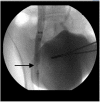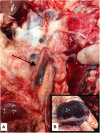Fatal Ovarian Hemorrhage Associated With Anticoagulation Therapy in a Yucatan Mini-Pig Following Venous Stent Implantation
- PMID: 32083102
- PMCID: PMC7002391
- DOI: 10.3389/fvets.2020.00018
Fatal Ovarian Hemorrhage Associated With Anticoagulation Therapy in a Yucatan Mini-Pig Following Venous Stent Implantation
Abstract
Swine models are commonly utilized in endovascular research for development of intravascular interventions and medical device development. As part of a pilot study for a venous vascular stent device, a 5-year-old female Yucatan mini-pig underwent bilateral external iliac vein stent placement under general anesthesia. To reduce thrombotic complications by reduction of thrombus formation on wires, sheaths, and catheters, the pig was heparinized with a total of 300 IU/kg of heparin, establishing an activated clotting time (ACT) of 436 s. The ACT had returned to below 200 s by the end of the procedure. To prevent postoperative thrombosis, the pig received an anticoagulation therapy protocol consisting of enoxaparin, clopidogrel, and aspirin. There were no complications during the immediate postoperative period. However, the pig died 4 days after surgery. Necropsy established the cause of death as abdominal exsanguination due to severe, acute, intra-ovarian hemorrhage, most likely related to ovulation. Life-threatening ovarian hemorrhage is occasionally seen in women with congenital or acquired bleeding disorders; to our knowledge this is the first report of fatal ovarian hemorrhage in an animal enrolled in a pre-clinical research trial.
Keywords: animal model; bleed; endovascular; ovary; pre-clinical.
Copyright © 2020 Boorman, Douglas, Driessen, Gillespie and Schaer.
Figures



Similar articles
-
Endovascular Treatment of Thrombosis and Embolism.Adv Exp Med Biol. 2017;906:195-213. doi: 10.1007/5584_2016_116. Adv Exp Med Biol. 2017. PMID: 27664152 Review.
-
May-Thurner Syndrome: A Rare and Under-Appreciated Cause of Venous Thrombosis in a 18-Year-Old Healthy Female.J Hematol. 2018 Sep;7(3):112-115. doi: 10.14740/jh381w. Epub 2018 Sep 1. J Hematol. 2018. PMID: 32300423 Free PMC article.
-
Venovenous Extracorporeal Membrane Oxygenation With Prophylactic Subcutaneous Anticoagulation Only: An Observational Study in More Than 60 Patients.Artif Organs. 2017 Feb;41(2):186-192. doi: 10.1111/aor.12737. Epub 2016 Jun 3. Artif Organs. 2017. PMID: 27256966
-
Cerebral venous congestion as indication for thrombolytic treatment.Cardiovasc Intervent Radiol. 2007 Jul-Aug;30(4):675-87. doi: 10.1007/s00270-007-9046-1. Cardiovasc Intervent Radiol. 2007. PMID: 17573553
-
Rationale for low-molecular weight heparin in coronary stenting.Am Heart J. 1997 Nov;134(5 Pt 2):S81-7. Am Heart J. 1997. PMID: 9396639 Review.
Cited by
-
The Influence of Zearalenone on Selected Hemostatic Parameters in Sexually Immature Gilts.Toxins (Basel). 2021 Sep 6;13(9):625. doi: 10.3390/toxins13090625. Toxins (Basel). 2021. PMID: 34564628 Free PMC article.
References
Publication types
LinkOut - more resources
Full Text Sources
Research Materials

